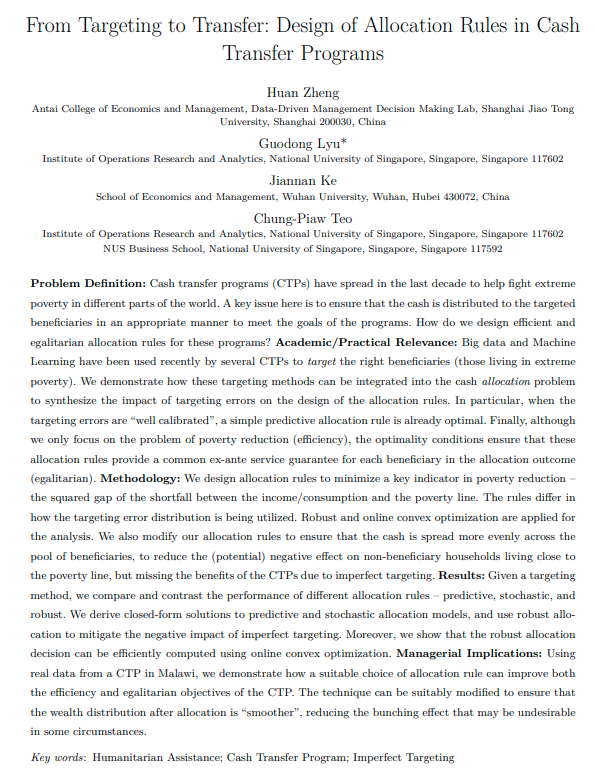Problem Definition: Cash transfer programs (CTPs) have spread in the last decade to help fight extreme poverty in different parts of the world. A key issue here is to ensure that the cash is distributed to the targeted beneficiaries in an appropriate manner to meet the goals of the programs. How do we design efficient and egalitarian allocation rules for these programs?
Academic/Practical Relevance: Big data and Machine Learning have been used recently by several CTPs to target the right beneficiaries (those living in extreme poverty). We demonstrate how these targeting methods can be integrated into the cash allocation problem to synthesize the impact of targeting errors on the design of the allocation rules. In particular, when the targeting errors are “well calibrated”, a simple predictive allocation rule is already optimal. Finally, although we only focus on the problem of poverty reduction (efficiency), the optimality conditions ensure that these allocation rules provide a common ex-ante service guarantee for each beneficiary in the allocation outcome (egalitarian).
Methodology: We design allocation rules to minimize a key indicator in poverty reduction — the squared gap of the shortfall between the income/consumption and the poverty line. The rules differ in how the targeting error distribution is being utilized. Robust and online convex optimization are applied for the analysis. We also modify our allocation rules to ensure that the cash is spread
more evenly across the pool of beneficiaries, to reduce the (potential) negative effect on non-beneficiary households living close to the poverty line, but missing the benefits of the CTPs due to imperfect targeting.
Results: Given a targeting method, we compare and contrast the performance of different allocation rules — predictive, stochastic, and robust. We derive closed-form solutions to predictive and stochastic allocation models, and use robust allocation to mitigate the negative impact of imperfect targeting. Moreover, we show that the robust allocation decision can be efficiently computed using online convex optimization.
Managerial Implications: Using real data from a CTP in Malawi, we demonstrate how a suitable choice of allocation rule can improve both the efficiency and egalitarian objectives of the CTP. The technique can be suitably modified to ensure that the wealth distribution after allocation is “smoother”, reducing the bunching effect that may be undesirable in some circumstances.


